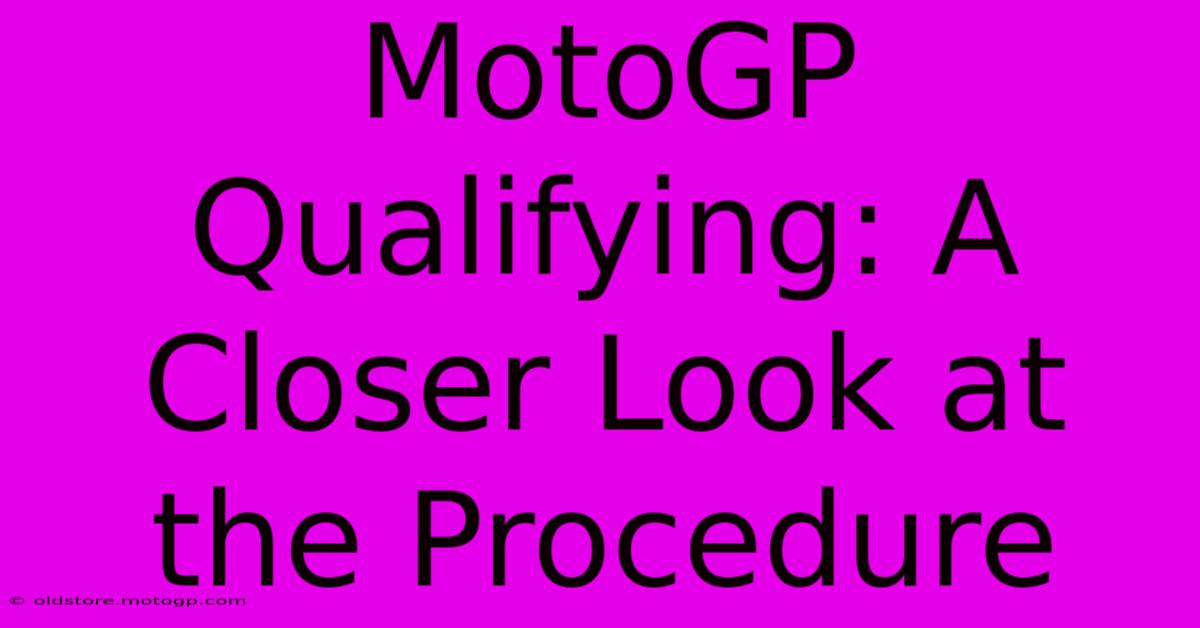MotoGP Qualifying: A Closer Look At The Procedure

Table of Contents
MotoGP Qualifying: A Closer Look at the Procedure
MotoGP qualifying is a crucial stage determining the starting grid for the race. The drama, the close calls, and the ultimate fight for pole position captivate millions of fans worldwide. But what exactly is the qualifying procedure, and how does it work? This in-depth guide will break down the process, explaining each session and the strategies employed by riders and teams.
Understanding the Qualifying Format
The MotoGP qualifying format has evolved over the years, aiming to deliver exciting sessions and a fair representation of rider skill. Currently, the process unfolds across three sessions:
Q1: The First Cut
Q1 (Qualifying 1) is where the battle begins. The 10 slowest riders from the combined Free Practice (FP) sessions 1, 2, and 3 find themselves here. These riders have a 15-minute window to prove themselves. Only the top two riders from Q1 progress to Q2. The pressure is immense; every tenth of a second counts. Strategies often involve pushing hard from the outset to secure a safe passage, sometimes sacrificing a perfect lap for a consistent fast one. Expect close racing and daring overtakes in this high-stakes session.
Q2: The Fight for Pole
Q2 (Qualifying 2) is where the elite compete. The top 10 riders from FP, combined with the two fastest riders from Q1, make up the grid. This 15-minute session is even more intense than Q1. The fight for pole position—the coveted first place on the starting grid—is fierce. Expect finely tuned bikes, perfectly executed laps, and strategic tire management. Every rider aims for that perfect lap, a combination of flawless lines, precise braking, and aggressive acceleration. The pressure to secure a front-row start is immense, significantly impacting the race outcome.
Crucial Aspects of MotoGP Qualifying
Several key aspects contribute to success in MotoGP qualifying:
Tire Choice: A Critical Decision
Choosing the right tires is crucial. Different tire compounds offer varying levels of grip and durability. Riders and their teams must analyze weather conditions, track temperature, and race strategy to select the optimal tire for each qualifying session. The wrong choice can mean the difference between a front-row start and a mid-grid position.
Slipstream Tactics: The Art of Drafting
Slipstreaming, or drafting, is a significant factor. Riders gain a considerable speed advantage by following closely behind another bike. This strategic positioning is often used to improve lap times, especially on straights. Teams and riders coordinate these maneuvers meticulously, aiming to gain a crucial speed boost while reducing aerodynamic drag.
Track Conditions: A Dynamic Factor
The ever-changing track conditions, including temperature and grip levels, play a pivotal role. Riders need to constantly adapt their riding style and machine setup to maximize performance. A slight change in track temperature or humidity can significantly alter tire grip and lap times, demanding constant adjustments.
Qualifying Simulation: The Practice Runs
Before qualifying, teams spend Free Practice sessions (FP1, FP2, FP3) intensely analyzing track conditions, tire performance, and bike setups. They often conduct qualifying simulations, performing race-paced laps to predict tire degradation and optimize strategies for the actual qualifying sessions.
The Impact of Qualifying on the Race
Starting position is significantly related to the final race result. A front-row start gives riders a massive advantage, allowing them to dictate the race pace and avoid early-race congestion. A poor qualifying performance, on the other hand, makes overtaking considerably harder, sometimes making it extremely challenging to secure a podium finish.
Conclusion: More Than Just a Time Trial
MotoGP qualifying is more than just a time trial; it's a strategic battle, a blend of raw speed, technical skill, and calculated risk. Understanding the intricacies of the qualifying procedure provides a deeper appreciation for the effort and expertise required to secure a strong starting position and ultimately contend for victory. The drama, tension, and high stakes are what make MotoGP qualifying one of the most exciting parts of the Grand Prix weekend.

Thank you for visiting our website wich cover about MotoGP Qualifying: A Closer Look At The Procedure. We hope the information provided has been useful to you. Feel free to contact us if you have any questions or need further assistance. See you next time and dont miss to bookmark.
Featured Posts
-
Moto Gp Arcade Start Your Engines
Feb 25, 2025
-
High Octane Thrills Must See Moto Gp Pictures
Feb 25, 2025
-
Moto Gp Horsepower Faster Than You Can Imagine
Feb 25, 2025
-
Sprint Races Reshaping The World Of Moto Gp
Feb 25, 2025
-
Malaysia Moto Gp Get Ready For The Roar
Feb 25, 2025
